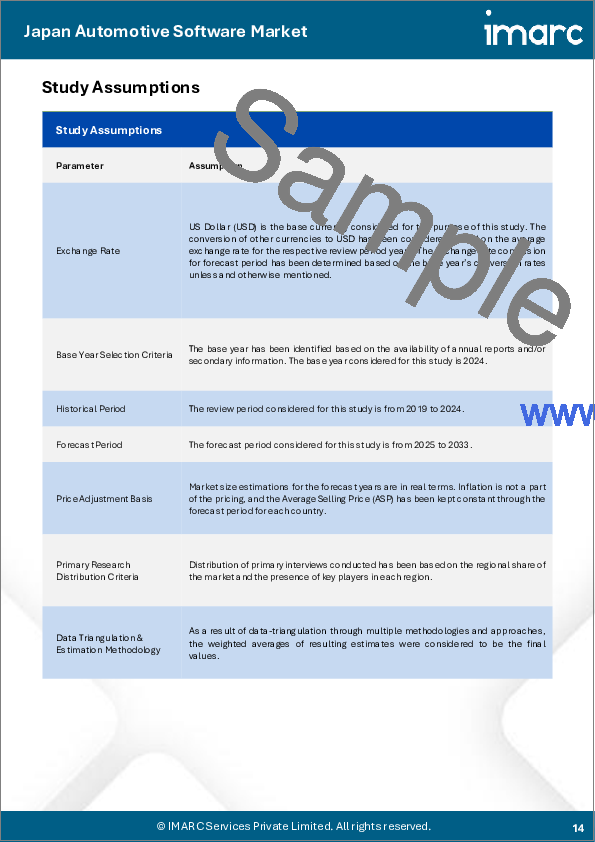|
|
市場調査レポート
商品コード
1746578
日本の自動車ソフトウェア市場レポート:製品、車種、用途、地域別、2025~2033年Japan Automotive Software Market Report by Product, Vehicle Type, Application, and Region 2025-2033 |
||||||
カスタマイズ可能
|
|||||||
| 日本の自動車ソフトウェア市場レポート:製品、車種、用途、地域別、2025~2033年 |
|
出版日: 2025年06月02日
発行: IMARC
ページ情報: 英文 122 Pages
納期: 5~7営業日
|
全表示
- 概要
- 目次
日本の自動車ソフトウェア市場規模は2024年に11億米ドルに達しました。今後、IMARC Groupは、2033年には39億米ドルに達し、2025~2033年にかけて14.54%の成長率(CAGR)を示すと予測しています。安全性、効率性、接続性を中心とした先進的な車両機能に対する消費者需要の高まり、継続的な技術革新、国全体の厳しい政府規制などが、市場を牽引する主要因のひとつです。
本レポートで扱う主要質問
- 日本の自動車ソフトウェア市場はこれまでどのように推移し、今後どのように推移するのか?
- COVID-19が日本の自動車ソフトウェア市場に与えた影響は?
- 日本の自動車ソフトウェア市場の製品別区分は?
- 日本の自動車ソフトウェア市場の車種別区分は?
- 日本の自動車ソフトウェア市場の用途別区分は?
- 日本の自動車ソフトウェア市場のバリューチェーンにおける各段階とは?
- 日本の自動車ソフトウェアの主要な促進要因と課題は?
- 日本の自動車ソフトウェア市場の構造と主要参入企業は?
- 日本の自動車ソフトウェア市場における競合の程度は?
目次
第1章 序文
第2章 調査範囲と調査手法
- 調査の目的
- ステークホルダー
- データソース
- 市場推定
- 調査手法
第3章 エグゼクティブサマリー
第4章 日本の自動車ソフトウェア市場-イントロダクション
- 概要
- 市場力学
- 産業動向
- 競合情報
第5章 日本の自動車ソフトウェア市場情勢
- 過去と現在の市場動向(2019~2024年)
- 市場予測(2025~2033年)
第6章 日本の自動車ソフトウェア市場-製品別内訳
- アプリケーションソフトウェア
- ミドルウェア
- オペレーティングシステム
第7章 日本の自動車ソフトウェア市場-車種別内訳
- ICE乗用車
- ICE軽商用車
- ICE大型商用車
- バッテリー電気自動車
- ハイブリッド電気自動車
- プラグインハイブリッド電気自動車
- 自動運転車
第8章 日本の自動車ソフトウェア市場-用途別内訳
- 安全とセキュリティ
- インフォテインメントと計器クラスター
- 車両接続性
第9章 日本の自動車ソフトウェア市場-競合情勢
- 概要
- 市場構造
- 市場企業のポジショニング
- 主要成功戦略
- 競合ダッシュボード
- 企業評価象限
第10章 主要企業のプロファイル
第11章 日本の自動車ソフトウェア市場-産業分析
- 促進要因・抑制要因・機会
- ポーターのファイブフォース分析
- バリューチェーン分析
第12章 付録
The Japan automotive software market size reached USD 1.1 Billion in 2024. Looking forward, IMARC Group expects the market to reach USD 3.9 Billion by 2033, exhibiting a growth rate (CAGR) of 14.54% during 2025-2033. The rising consumer demand for advanced vehicle features, especially in safety, efficiency, and connectivity, ongoing technological innovation and stringent government regulations across the country, represent some of the key factors driving the market.
Automotive software refers to the digital programs and systems integrated within vehicles to enhance their functionality, safety, and user experience. This software encompasses a wide range of applications, from basic operating systems that manage vehicle hardware to advanced solutions for autonomous driving, connectivity, and infotainment. Key areas of automotive software include engine management systems, which optimize performance and fuel efficiency, and safety systems, like anti-lock braking and airbag deployment. The growing field of infotainment integrates navigation, multimedia, and connectivity features, offering a seamless and interactive experience for drivers and passengers. Telematics software also plays a vital role in real-time vehicle monitoring, offering insights into vehicle health, driving patterns, and maintenance needs. With the advent of electric and autonomous vehicles, automotive software is increasingly focusing on battery management, advanced driver-assistance systems (ADAS), and self-driving algorithms. These technologies rely heavily on software for data processing, decision-making, and ensuring safety and compliance with regulatory standards. At present, automotive software is gaining traction as a critical component, transforming the way vehicles operate, communicate, and interact with users and the environment.
Japan Automotive Software Market Trends:
The Japan automotive software market is experiencing significant growth, driven by a multitude of factors. One of the key drivers propelling the market growth includes rapid technological innovation. Japan, known for its technological prowess, is at the forefront of developing advanced automotive technologies. Apart from this, the global push toward electric vehicles (EVs) and autonomous driving is leading to a heightened demand for software for battery management systems in EVs and algorithms for autonomous vehicles, further fueling market growth. Additionally, the Japanese government's stringent regulations and policies regarding vehicle safety and emissions are compelling automakers to integrate sophisticated software solutions. These regulations necessitate advanced engine management systems and emissions control software, driving market growth. Besides this, Japanese consumers have a strong preference for vehicles equipped with the latest technology, which is catalyzing the demand for advanced infotainment systems, connectivity features, and driver-assistance technologies, all of which rely heavily on software. Furthermore, Japan's automotive industry, home to global giants like Toyota and Honda, is highly competitive. This competition fosters innovation, resulting in the development of cutting-edge automotive software solutions. In line with this, the increasing collaborations among automotive companies and tech firms in Japan facilitate the development of new software solutions and technologies, contributing to market growth. Moreover, the rising focus on safety and driving assistance technologies due to an aging population has augmented the demand for software solutions that offer advanced safety features and improve vehicle efficiency. Along with this, Japan's role as a key player in the global automotive industry spurs the development of automotive software in the country, thus accelerating market growth.
Japan Automotive Software Market Segmentation:
Product Insights:
- Application Software
- Middleware
- Operating System
Vehicle Type Insights:
- ICE Passenger Vehicle
- ICE Light Commercial Vehicle
- ICE Heavy Commercial Vehicle
- Battery Electric Vehicle
- Hybrid Electric Vehicle
- Plug-in Hybrid Electric Vehicle
- Autonomous Vehicles
Application Insights:
- Safety and Security
- Infotainment and Instrument Cluster
- Vehicle Connectivity
- Others
Competitive Landscape:
The market research report has also provided a comprehensive analysis of the competitive landscape. Competitive analysis such as market structure, key player positioning, top winning strategies, competitive dashboard, and company evaluation quadrant has been covered in the report. Also, detailed profiles of all major companies have been provided.
Key Questions Answered in This Report:
- How has the Japan automotive software market performed so far and how will it perform in the coming years?
- What has been the impact of COVID-19 on the Japan automotive software market?
- What is the breakup of the Japan automotive software market on the basis of product?
- What is the breakup of the Japan automotive software market on the basis of vehicle type?
- What is the breakup of the Japan automotive software market on the basis of application?
- What are the various stages in the value chain of the Japan automotive software market?
- What are the key driving factors and challenges in the Japan automotive software?
- What is the structure of the Japan automotive software market and who are the key players?
- What is the degree of competition in the Japan automotive software market?
Table of Contents
1 Preface
2 Scope and Methodology
- 2.1 Objectives of the Study
- 2.2 Stakeholders
- 2.3 Data Sources
- 2.3.1 Primary Sources
- 2.3.2 Secondary Sources
- 2.4 Market Estimation
- 2.4.1 Bottom-Up Approach
- 2.4.2 Top-Down Approach
- 2.5 Forecasting Methodology
3 Executive Summary
4 Japan Automotive Software Market - Introduction
- 4.1 Overview
- 4.2 Market Dynamics
- 4.3 Industry Trends
- 4.4 Competitive Intelligence
5 Japan Automotive Software Market Landscape
- 5.1 Historical and Current Market Trends (2019-2024)
- 5.2 Market Forecast (2025-2033)
6 Japan Automotive Software Market - Breakup by Product
- 6.1 Application Software
- 6.1.1 Overview
- 6.1.2 Historical and Current Market Trends (2019-2024)
- 6.1.3 Market Forecast (2025-2033)
- 6.2 Middleware
- 6.2.1 Overview
- 6.2.2 Historical and Current Market Trends (2019-2024)
- 6.2.3 Market Forecast (2025-2033)
- 6.3 Operating System
- 6.3.1 Overview
- 6.3.2 Historical and Current Market Trends (2019-2024)
- 6.3.3 Market Forecast (2025-2033)
7 Japan Automotive Software Market - Breakup by Vehicle Type
- 7.1 ICE Passenger Vehicle
- 7.1.1 Overview
- 7.1.2 Historical and Current Market Trends (2019-2024)
- 7.1.3 Market Forecast (2025-2033)
- 7.2 ICE Light Commercial Vehicle
- 7.2.1 Overview
- 7.2.2 Historical and Current Market Trends (2019-2024)
- 7.2.3 Market Forecast (2025-2033)
- 7.3 ICE Heavy Commercial Vehicle
- 7.3.1 Overview
- 7.3.2 Historical and Current Market Trends (2019-2024)
- 7.3.3 Market Forecast (2025-2033)
- 7.4 Battery Electric Vehicle
- 7.4.1 Overview
- 7.4.2 Historical and Current Market Trends (2019-2024)
- 7.4.3 Market Forecast (2025-2033)
- 7.5 Hybrid Electric Vehicle
- 7.5.1 Overview
- 7.5.2 Historical and Current Market Trends (2019-2024)
- 7.5.3 Market Forecast (2025-2033)
- 7.6 Plug-in Hybrid Electric Vehicle
- 7.6.1 Overview
- 7.6.2 Historical and Current Market Trends (2019-2024)
- 7.6.3 Market Forecast (2025-2033)
- 7.7 Autonomous Vehicles
- 7.7.1 Overview
- 7.7.2 Historical and Current Market Trends (2019-2024)
- 7.7.3 Market Forecast (2025-2033)
8 Japan Automotive Software Market - Breakup by Application
- 8.1 Safety and Security
- 8.1.1 Overview
- 8.1.2 Historical and Current Market Trends (2019-2024)
- 8.1.3 Market Forecast (2025-2033)
- 8.2 Infotainment and Instrument Cluster
- 8.2.1 Overview
- 8.2.2 Historical and Current Market Trends (2019-2024)
- 8.2.3 Market Forecast (2025-2033)
- 8.3 Vehicle Connectivity
- 8.3.1 Overview
- 8.3.2 Historical and Current Market Trends (2019-2024)
- 8.3.3 Market Forecast (2025-2033)
- 8.4 Infotainment and Instrument Cluster
- 8.4.1 Historical and Current Market Trends (2019-2024)
- 8.4.2 Market Forecast (2025-2033)
9 Japan Automotive Software Market - Competitive Landscape
- 9.1 Overview
- 9.2 Market Structure
- 9.3 Market Player Positioning
- 9.4 Top Winning Strategies
- 9.5 Competitive Dashboard
- 9.6 Company Evaluation Quadrant
10 Profiles of Key Players
- 10.1 Company A
- 10.1.1 Business Overview
- 10.1.2 Product Portfolio
- 10.1.3 Business Strategies
- 10.1.4 SWOT Analysis
- 10.1.5 Major News and Events
- 10.2 Company B
- 10.2.1 Business Overview
- 10.2.2 Product Portfolio
- 10.2.3 Business Strategies
- 10.2.4 SWOT Analysis
- 10.2.5 Major News and Events
- 10.3 Company C
- 10.3.1 Business Overview
- 10.3.2 Product Portfolio
- 10.3.3 Business Strategies
- 10.3.4 SWOT Analysis
- 10.3.5 Major News and Events
- 10.4 Company D
- 10.4.1 Business Overview
- 10.4.2 Product Portfolio
- 10.4.3 Business Strategies
- 10.4.4 SWOT Analysis
- 10.4.5 Major News and Events
- 10.5 Company E
- 10.5.1 Business Overview
- 10.5.2 Product Portfolio
- 10.5.3 Business Strategies
- 10.5.4 SWOT Analysis
- 10.5.5 Major News and Event
11 Japan Automotive Software Market - Industry Analysis
- 11.1 Drivers, Restraints, and Opportunities
- 11.1.1 Overview
- 11.1.2 Drivers
- 11.1.3 Restraints
- 11.1.4 Opportunities
- 11.2 Porters Five Forces Analysis
- 11.2.1 Overview
- 11.2.2 Bargaining Power of Buyers
- 11.2.3 Bargaining Power of Suppliers
- 11.2.4 Degree of Competition
- 11.2.5 Threat of New Entrants
- 11.2.6 Threat of Substitutes
- 11.3 Value Chain Analysis






